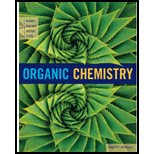
Concept explainers
(a)
Interpretation:
Polar molecules and the direction of its dipole moment have to be identified.
Concept introduction:
Polar Molecules:
Polar Molecules contains partial positive and partial negative charge in the molecule due its electronegativity difference between the molecules.
Dipole moment:
The charge separation of the molecule produces dipole moment. Dipole moment arises between two ions in an ionic bond or covalent bond.
Dipole moment depends on the differences in electronegativity of the atom in the molecule. The electronegativity is more, the larger the dipole moment. The dipole moment is calculated from the polarity of the molecule.
(b)
Interpretation:
Polar molecules and the direction of its dipole moment have to be identified.
Concept introduction:
Polar Molecules:
Polar Molecules contains partial positive and partial negative charge in the molecule due its electronegativity difference between the molecules.
Dipole moment:
The charge separation of the molecule produces dipole moment. Dipole moment arises between two ions in an ionic bond or covalent bond.
Dipole moment depends on the differences in electronegativity of the atom in the molecule. The electronegativity is more, the larger the dipole moment. The dipole moment is calculated from the polarity of the molecule.
(c)
Interpretation:
Polar molecules and the direction of its dipole moment have to be identified.
Concept introduction:
Polar Molecules:
Polar Molecules contains partial positive and partial negative charge in the molecule due its electronegativity difference between the molecules.
Dipole moment:
The charge separation of the molecule produces dipole moment. Dipole moment arises between two ions in an ionic bond or covalent bond.
Dipole moment depends on the differences in electronegativity of the atom in the molecule. The electronegativity is more, the larger the dipole moment. The dipole moment is calculated from the polarity of the molecule.
Want to see the full answer?
Check out a sample textbook solution
Chapter 1 Solutions
ORGANIC CHEMISTRY-OWL V2 ACCESS
- Please help me solve this reaction.arrow_forwardIndicate the products obtained by mixing 2,2-dimethylpropanal with acetaldehyde and sodium ethoxide in ethanol.arrow_forwardSynthesize 2-Ethyl-3-methyloxirane from dimethyl(propyl)sulfonium iodide using the necessary organic or inorganic reagents. Draw the structures of the compounds.arrow_forward
- Synthesize 2-Hydroxy-2-phenylacetonitrile from phenylmethanol using the necessary organic or inorganic reagents. Draw the structures of the compounds.arrow_forwardSynthesize N-Methylcyclohexylamine from cyclohexanol using the necessary organic or inorganic reagents. Draw the structures of the compounds.arrow_forwardSynthesize N-Methylcyclohexylamine from cyclohexanol using the necessary organic or inorganic reagents. Draw the structures of the compounds.arrow_forward
- If possible, please provide the formula of the compound 3,3-dimethylbut-2-enal.arrow_forwardSynthesize 1,4-dibromobenzene from acetanilide (N-phenylacetamide) using the necessary organic or inorganic reagents. Draw the structures of the compounds.arrow_forwardIndicate the products obtained by mixing (3-oxo-3-phenylpropyl)triphenylphosphonium bromide with sodium hydride.arrow_forward
- We mix N-ethyl-2-hexanamine with excess methyl iodide and followed by heating with aqueous Ag2O. Indicate the major products obtained.arrow_forwardIndicate the products obtained by mixing acetophenone with iodine and NaOH.arrow_forwardIndicate the products obtained by mixing 2-Propanone and ethyllithium and performing a subsequent acid hydrolysis.arrow_forward
 ChemistryChemistryISBN:9781305957404Author:Steven S. Zumdahl, Susan A. Zumdahl, Donald J. DeCostePublisher:Cengage Learning
ChemistryChemistryISBN:9781305957404Author:Steven S. Zumdahl, Susan A. Zumdahl, Donald J. DeCostePublisher:Cengage Learning ChemistryChemistryISBN:9781259911156Author:Raymond Chang Dr., Jason Overby ProfessorPublisher:McGraw-Hill Education
ChemistryChemistryISBN:9781259911156Author:Raymond Chang Dr., Jason Overby ProfessorPublisher:McGraw-Hill Education Principles of Instrumental AnalysisChemistryISBN:9781305577213Author:Douglas A. Skoog, F. James Holler, Stanley R. CrouchPublisher:Cengage Learning
Principles of Instrumental AnalysisChemistryISBN:9781305577213Author:Douglas A. Skoog, F. James Holler, Stanley R. CrouchPublisher:Cengage Learning Organic ChemistryChemistryISBN:9780078021558Author:Janice Gorzynski Smith Dr.Publisher:McGraw-Hill Education
Organic ChemistryChemistryISBN:9780078021558Author:Janice Gorzynski Smith Dr.Publisher:McGraw-Hill Education Chemistry: Principles and ReactionsChemistryISBN:9781305079373Author:William L. Masterton, Cecile N. HurleyPublisher:Cengage Learning
Chemistry: Principles and ReactionsChemistryISBN:9781305079373Author:William L. Masterton, Cecile N. HurleyPublisher:Cengage Learning Elementary Principles of Chemical Processes, Bind...ChemistryISBN:9781118431221Author:Richard M. Felder, Ronald W. Rousseau, Lisa G. BullardPublisher:WILEY
Elementary Principles of Chemical Processes, Bind...ChemistryISBN:9781118431221Author:Richard M. Felder, Ronald W. Rousseau, Lisa G. BullardPublisher:WILEY





